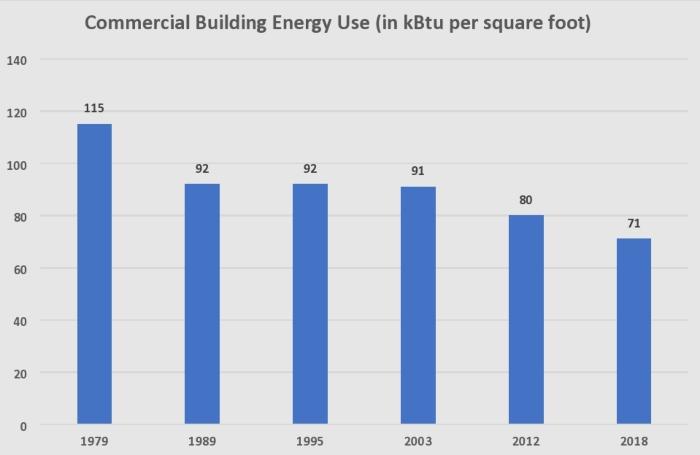Commercial buildings use a lot of energy, about 12% of total U.S. energy consumption, according to the U.S. Department of Energy (DOE). However, commercial buildings overall are becoming more efficient.
The DOE began tracking commercial building energy use in 1979 with its first Commercial Building Energy Consumption Survey. At that time, the average annual energy use intensity for commercial buildings was 115 thousand British thermal units (kBtu) per square foot of building space. That number has gradually decreased over time, as subsequent surveys have noted. In the most recent 2018 survey (released in 2022), average building energy use had fallen to 71 kBtu per square foot, a reduction of 38% since 1979.

This drop in energy use is good news for building owners and operators — and the environment. Building owners and operators are spending less on their energy bills, while less energy use means lower emissions, which is good for the planet.
Improving the Energy Efficiency of Your Building
Is your building part of this energy efficiency trend? If not, maybe it's time you started taking steps to reduce your energy use. You'll reduce operating costs, improve comfort and demonstrate your organization's commitment to sustainability.
A great way to start is by comparing your energy use to similar buildings. That's where ENERGY STAR® Portfolio Manager™ comes in. This is a no-cost online tool offered by the U.S. Environment Protection Agency (EPA). After answering some simple questions about your building and energy use, you'll receive an energy performance score that will tell you where your building stands. It will also give you a starting point to explore and prioritize energy-saving opportunities.
While every building is different, here are some of the most effective ways to improve energy efficiency:
- Check your HVAC. Have your heating and cooling systems cleaned and inspected once a year by a qualified professional. If your system is older or in need of repair, consider replacing it with a newer, more efficient system.
- Weatherize your building envelope. Make sure your windows and doors are properly sealed. Hire an insulation contractor to ensure that your building is well-insulated according to the minimum recommended levels for your climate zone.
- Take control. Install and implement building system controls to reduce energy use based on occupancy or your operating schedule.
- Upgrade your lighting. LEDs are more efficient and last longer than conventional lighting technologies, and there are a variety of replacement options available.
Long-term Savings Requires Planning
A successful energy management plan can help your organization fully realize the benefits of improved energy efficiency over time. The EPA has developed a multi-step process for energy management that includes the following steps:
- Make a commitment. Allocate staff and funding to achieve continuous improvement.
- Assess performance. Collect, measure and benchmark your energy use.
- Set goals. Define clear and measurable energy-saving goals and establish guidelines for performance improvement.
- Implement an action plan. Develop and implement a process for implementing measures to achieve your energy-saving goals.
- Evaluate progress. Regularly review energy-use data and compare the results to your performance goals.
- Recognize achievements. Publicize performance improvement to help sustain support for the program.
Earning ENERGY STAR® Building Certification is a worthy objective for your energy management program to work toward, and an excellent way to publicize your organization's commitment to energy efficiency. For more information, see the EPA's Guidelines for Energy Management.
Connections Newsletter for August 2023
From industry trends and best practices to sustainability initiatives, our monthly Connections Newsletter provides valuable insights, updates, and resources to support our large business customers.
Full Newsletter